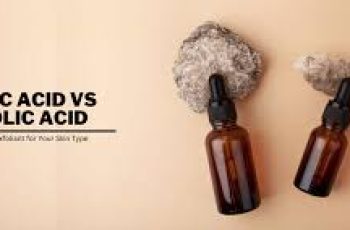
I Tried Glacial Rx—The Newest CryoAesthetic Treatment—And My Skin Has Never Looked Better
The best part of waking up is when I finally get to ice roll my face, as it helps de-puff and add that extra radiance I desperately need in the morning. Cold therapy is one of my favorite, albeit cheapest, and most immediately effective parts of my skincare routine. So you can probably imagine I jumped at the chance to try Glacial Rx, a brand new CryoAesthetic treatment (i.e., a cold facial treatment) that promises to illuminate the skin and reduce age spots and hyperpigmentation in the most painless way possible.
After researching the treatment before my first trip to Shafer Clinic, I wondered, How can a device that sounds similar to my cheap ice roller have such an effect on hyperpigmentation and redness? Upon arriving at the clinic in Manhattan, I was greeted by Lucia Miranda LE CME, who would perform the treatment on me. I explained my struggles with hyperpigmentation and how I constantly work to prevent flare-ups (usually heat and sun-related). She assured me that I would not only love the treatment but that this newer technology might be the key to solving my problems once and for all. Ahead, learn everything you need to know about Glacial Rx.
What Is Glacial Rx?
“Glacial Rx is an FDA-cleared CryoAesthetic treatment that uses precision cooling technology to brighten skin, reduce redness and accelerate exfoliation,” Dr. Dendy Engelman, board-certified dermatologist at the Shafer Clinic in NYC, explains. “It is also cleared to remove benign lesions—like solar lentigines and macular seborrheic keratoses.” Dr. Engelman says the treatment uses a newer technology called Cryomodulation, which “harnesses cold to suppress the production of melanin, reduce age spots, and pigmentation.”
Dr. Bruce Katz, director of Juva Skin and Laser Center in New York City, conducts clinical studies on Glacial Rx, and his clinic was the first one in the country to have the treatment. Dr. Katz explained in greater detail how Cryomodulation works: “When people develop hyperpigmentation, there is a mechanism involving tyrosinase, an enzyme that stimulates pigment cells to produce pigment, and the Cryomodulation, the cold technology, stops that event from happening.” Dr. Katz added that the treatment was developed at Harvard by the same scientists who created CoolSculpting.
The Glacial Rx treatment includes three treatment modalities, though it’s noted to be a two-step treatment, the third being a targeted spot treatment.
Benefits of Glacial Rx
Reduces redness and inflammation
Helps with and reduces hyperpigmentation and dark spots
Reduces skin dullness
Tightens the skin
“This treatment calms inflammation and leaves the skin bright and glowing,” Dr. Engelman says. “By offering two unique types of skin clearance, skin inflammation, and spot treatment, Glacial Rx works to break the inflammatory cycle to reduce inflammation resulting in calm, clear skin as well as remove benign lesions and dark spots.”
Dr. Katz says additional benefits to Glacial Rx are still being studied. “Aside from treating pigment and inflammation, we are also finding that it works quite well for rosacea,” he shares. “We are also treating psoriasis and looking at how it works on acne.” The benefits of Glacial Rx also go beyond the face: “We are using it on other parts of the body to treat pigment and inflammation,” Dr. Katz adds.
The treatment’s benefits can last up to a year, though further studies on this are needed, according to Dr. Katz. He also says you’ll notice results after one or two treatments. However, Dr. Engleman says, on average, patients will need about three treatments, depending on their goals. For example, I have gone for two treatments so far (one month apart) and have been recommended to have three treatments.
How to Prepare for Glacial Rx
Since I stopped my prescription Retin-A some time ago, there was nothing in my skincare routine that I had to stop before the treatment. However, for those that do, it is recommended that you discontinue any retinoid use 2-3 days prior and that you don’t get any filler or neurotoxins at least two weeks prior to the Glacial Rx treatment.
What to Expect During a Glacial Rx Treatment
Miranda, who performed my first and second treatments, only applied two of the three treatment modalities to my face. The Glacial Rx treatment uses a handheld device with what can be best described as a cold plate, the part your provider glides across your skin.
Miranda began the treatment with the “Gloss” technique, which involves skin cooling followed by dermabrasion. This modality is meant to treat the skin with continuous cooling, with the optional addition of topicals, to illuminate the skin by reducing inflammation and accelerating exfoliation. Dermabrasion tends to be a little harsh on my skin, but with the continuous cooling, it almost felt like nothing.
Afterward, she moved on to the second modality, the “Glide” technique. As Miranda tells me, this method “delivers precision cooling to the skin, resulting in calmer, and brighter looking skin almost immediately. It can be delivered as a standalone treatment or paired with lasers and other treatments to reduce pain, inflammation, and thermal injury.”
The final technique, which I did not need to utilize, is the Focused Freeze Spot Treatment (referred to as Precision Freezing). This technique is a targeted treatment that freezes benign lesions.
The entire treatment took about 45 minutes; it was so soothing and relaxing. As promised, the treatment left my skin bright and glowing, and with the addition of a few post-treatment topicals, I walked away looking like a glazed donut.
Before + After
During the winter months, my melasma/hyperpigmentation tends to calm down, though it is still present in some very harsh lights. However, with Glacial Rx, even after one treatment, I saw a massive difference in the reduction of my melasma and any redness in my skin, and with zero downtime. Other treatments I have done for my hyperpigmentation took a toll on my skin for a few days.
Potential Side Effects
Glacial Rx is safe for all skin types, pain-free, and has minimal to no side effects. Dr. Engleman says there is no downtime with the Gloss and Glide treatments. However, there can be several days of downtime with the spot treatment.
The Cost
The costs of Glacial Rx vary per provider but average around $550 per session. At Shafer Clinic, each of the three modalities has its own cost to allow for tailored treatment. The price is $800 for the Glide technique, $1,500 for Gloss, and $500 for the Focused Freeze Spot Treatment.
Aftercare
Patients are sent home with a branded Glacial Rx packet that includes mandelic pigment corrector serum and molecular barrier recovery cream balm. Dr. Katz also recommends continuing to hold off on using retinoids or harsher ingredients for a week after treatment in case your skin feels sensitive after treatment. Other than that, you can return to your everyday skincare routine. Regarding maintenance, Dr. Katz says you may need one or two touch-up treatments a year, but there is no final data on this yet.
The Final Takeaway
Glacial Rx delivers on its promise of radiant skin, reduced redness, and reduced hyperpigmentation. I wish I had tried this treatment sooner, but nonetheless, I am thrilled with my results. After just two treatments, I see a difference and look forward to my third. I love that this is a 45-minute treatment, so you can easily schedule it during a lunch break. And while Glacial Rx is a little pricey, it is worth it if you’re looking to address hyperpigmentation, redness, or benign lesions effectively and painlessly.


